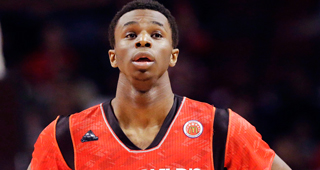"I think we ought to work awful hard with the NFL and the NBA to create an opportunity for those folks. We have it in baseball, we have it in golf, we have it in hockey. Why don't we have it in football, basketball? Why is it our job to be minor leagues for professional sports?" -- Big 10 commissioner Jim Delaney On the surface, this latest defense of the NCAA business model makes sense. If colleges don’t want to offer market salaries to the best 18-year-old football and basketball players, there’s nothing stopping the NFL and NBA from creating their own minor leagues. However, at least in the case of basketball, Delaney’s proposal is a solution in search of a problem. The last thing college basketball needs (or wants) is actual competition from the NBA. The good news, from the perspective of people like Delaney, is that the NBA has little interest in creating the infrastructure necessary for a baseball-like system. While investing in youth basketball in the US would improve their product, the league’s owners have never shown much interest in that type of long-term thinking. For the most part, it’s cash-in, cash-out. If it impacts the annual bottom-line, it’s not happening. If anything, the NBA would rather move the one-and-done rule the other way. All the advantages of making players wait one year after high school double with two. The more time they spend in college, the easier it is to evaluate them. Lottery teams don’t want projects who will take years to develop; they want fully-formed products that can be plugged in right away. They want as much value as possible from those cost-controlled rookie deals. Delaney can act like the NBA’s disinterest is a burden for the NCAA, but it’s really an opportunity. There are plenty of people who want to watch the best 18-20 year old basketball players in the world. While players at that age are still years away from reaching their prime, the most talented ones are good enough to create a reasonable facsimile of the NBA. Andrew Wiggins, Julius Randle and Jabari Parker -- people want to watch these guys play. Of course, more will watch them with Kansas, Kentucky and Duke than the Rio Grande Valley Vipers and Austin Toros. However, that doesn’t mean that college basketball would thrive without stars either. All you have to do is look at the relative popularity of college baseball, which has the same amount of tradition and pageantry. If the Top 50 in each high school class went pro every year, there would be less interest in March Madness. Last season, NCAA Tournament ratings were the highest they’ve been in 18 years. Coincidentally enough, 1995 was the year Kevin Garnett declared for the NBA draft, opening up the preps-to-pros floodwave. All of a sudden, with the very best players forgoing the NCAA, the sport began to slip in the national consciousness. If Wiggins and the Jayhawks are in the Final Four this season, it’s a safe bet that the ratings will be even higher than 2013. As someone who was a student at Texas when Kevin Durant was there, I find it hard to believe that the one-and-done rule is bad for college basketball. KD played one season with the Longhorns and had his jersey retired. That’s how much he’s beloved at Texas. Ten years later, how do Syracuse fans feel about Carmelo Anthony’s one year in school? If LeBron James had spent a year at Ohio State, that would have been a bad thing for the sport? All the publicity LeBron would have received might have exposed some of the inherent contradictions in the NCAA’s business model, but that isn’t the end of the world. While many fans would be turned off by eliminating amateurism, most would come back, if they ever left at all. Twenty years after the Olympics allowed professional athletes to compete, they are bigger than ever. Amateurism is not why sports are popular. In the case of the NCAA, it’s just simple math. There are nearly 300 metro areas in the US with a population of over 100,000, but only 30 NBA franchises and 32 NFL ones. Those other cities, they have sports fans too. They would like to attend sporting events and root for the home team. Look at how Fort Myers rallied around “Dunk City” last year; in what other context would that community be relevant on a national level? In that corner of Southwest Florida, FGCU is the biggest show in town. From the point of view of the fans watching the games, it doesn’t matter if the athletes are “paid” in scholarships or cash. At this point, whose kidding whom about what’s going on? Athletic departments are businesses that relentlessly try to maximize their revenues -- see the last few rounds of conference realignment. As long as the home team is winning, it’s all good. Paying players would not affect competitive balance all that much either. This season, John Calipari has five NBA prospects in his starting five at Kentucky ... and five NBA prospects coming off his bench. The distribution of talent is about as imbalanced as it could possibly be. At schools like Kentucky, the best players are professionals in all but name; just ask Ryan Harrow, whose attended N.C. State, Kentucky and Georgia State in the last four years. Whenever Kentucky goes to a rival campus this season, they will be the biggest show in town. Imagine what would happen if they still had Anthony Davis and Michael Kidd-Gilchrist. Now take it a step further and imagine a team of Calipari-coached millionaires losing in the Sweet 16 to a mid-major school that can only afford to pay players the cost of attendance. It would be the biggest sports story in the US!

Jonathan Tjarks wrote on the NBA for RealGM from 2011-2016 before joining The Ringer.
Follow @JonathanTjarks on Twitter.


